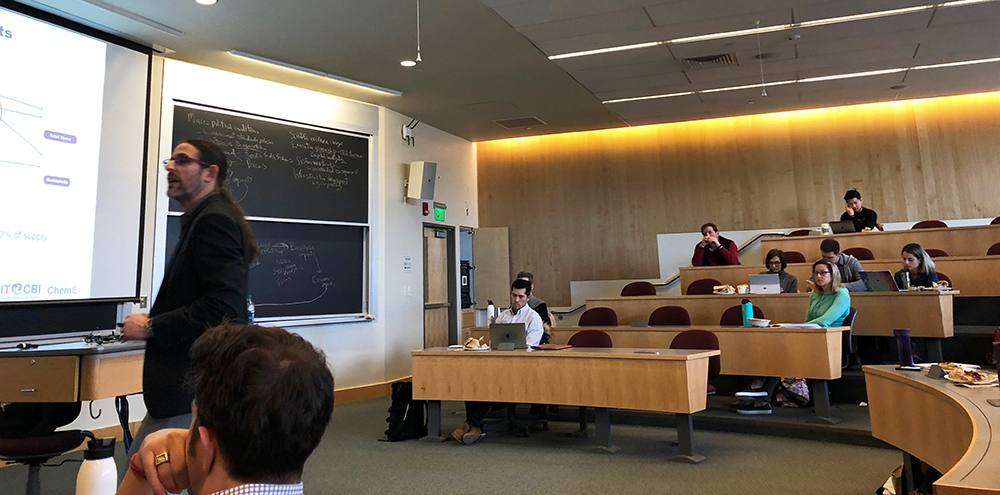News Pinpointing Risk in Food Supply Chains
Archana Apte, Communications and Program Assistant J-WAFS April 8, 2019

Photo Credit: Sarah Bastille, "An Emphasis on Health," MIT Spectrum
Food, water, and agriculture issues stem from a variety of causes, including the network of food delivery and processing that ensures smooth movement from farm to table. On Thursday, March 7th, Retsef Levi, professor of operations management in MIT's Sloan School of Management, discussed this very issue in a presentation on food supply chain management as part of the MIT Sloan Sustainability Initiative’s lunchtime presentation series. The talk covered supply chain optimization and food safety in particular, a research area of his that J-WAFS supported with a 2015 seed grant. Levi gave an overview of his team’s work in each area, highlighting the complexity of food chain management and how multidisciplinary collaboration can help solve issues in the field.
Levi began by making a strong argument for the importance of food chain management to the agriculture sector. He noted in particular that the efficient use of resources and ensuring farmer and consumer welfare are critical components to creating a healthy food system. Levi’s team, involving x, y, and z (who?), are working with Indian farmers on these issues in particular. In Karnataka, India, foods are traditionally bidden on in a local market by a small number of traders. Since the farmers can only choose between prices offered by local traders, and they do not have access to a fair market price for the goods they are selling, farmers cannot be sure that they are receiving a fair market price for their goods. Levi’s team found that once the farmers were able to use an online forum to access price information, their bargaining power at the local markets increased and they were able to obtain better prices for their goods.
One audience member noted, however, that in her field research in Karnataka, a lack of accessible transportation to ship the goods prevented farmers from actually selling their goods at the fair market price listed online. The audience member’s point spoke to Levi’s later coverage of agricultural supply chain structure in different countries. He explained that several key characteristics differentiate agriculture supply chains of India and China from those of developed countries such as the United States, and that these differences create unique challenges for the smooth, efficient movement of products. For instance, the agriculture supply base in India and China utilizes many, small, household farms, whereas more developed countries rely primarily on large, vertically integrated farms for output. Because it is more difficult to track food quality and Small farms present challenges with transparency and risk-sharing. Levi emphasized that understanding the context of food supply chains in different countries was essential for creating effective interventions in these various places.

Photo Credit: Archana Apte, Communications and Program Assistant, J-WAFS
Many of the projects Levi presented involved food safety and regulation. He noted that these issues are intertwined, and that one needs to understand supply chains to properly manage the associated regulatory risks. One of the projects—which received seed funding from J-WAFS—focused on the FDA inspection of shrimp supply chains, which are known for their high risk. The FDA must inspect shrimp suppliers for possible risk, but they can only inspect a small percentage of the total shrimp imports to the United States. Levi’s team took 1 million records of shrimp shipments and made risk models to pinpoint risky shrimp suppliers. The team found that companies without expertise in shrimp safety were more likely to have adulteration problems; specifically, organizations that specialized in the regulation of radically different items were more likely to pose food safety risks. The researchers also found that the FDA was highly predictable in which suppliers it would test, and that those suppliers tended to be low-risk. This testing practice could pose a risk to the shrimp food chain, since the FDA was not regularly testing problematic suppliers.
In a separate project, Levi’s researchers developed a method to pinpoint the source of a specific adulterant in a food chain in China. For instance, the team analyzed the risks associated with freshwater aquatic foods such as seafood, and found that farming alone presented 39% of risk to the supply chain. This project also enabled the researchers to pinpoint the high-risk manufacturers in a particular geographic area, by way of a newly designed visualization tool. Projects such as these can efficiently prevent food contamination; and, considering that much of the United States’ foodstuffs is imported, these interventions can have global effects.
Overall, Levi’s talk highlighted the importance of investigating regulatory environments and efficiently allocating resources to evaluate a risky food chain with limited resources. The talk highlighted the connection between supply chain management, social science research, and food safety issues, reflecting how important it is to take an interdisciplinary approach to research questions of this level of complexity in order to provide successful and actionable research results to support a more sustainable food system overall.
